Click On Any Picture For A Larger View

Thanks For The Visit !
Just Flight and Aeroplane Heaven bring you one of the most detailed WW II Bombers that I have had the pleasure of reviewing. That's not to say that other Lancaster models are not developed with great detail as well, it's simply that this model pushes the envelope in the detail department! Excellent modeling both inside and out makes this model stand out from the others! Before I start in on the review, let's take a look at this great, classic bomber of WW II.
The beginnings of the Lancaster have its roots back in 1936, when the British Air Ministry requested that a twin-engine bomber be developed, utilizing Rolls Royce engines. The Avro Manchester was the aircraft that came from this phase of development, and 200 were made, but were not successful, and production on the Manchester stopped. By 1940, they had redesigned the aircraft, and named it the Avro Lancaster Mk I. The Lancaster was powered by four Rolls Royce Merlin engines, with speeds up to 287 mph and a range of 1,660 miles. Defensive armament consisted of ten machine guns.
The beginnings of the Lancaster have its roots back in 1936, when the British Air Ministry requested that a twin-engine bomber be developed, utilizing Rolls Royce engines. The Avro Manchester was the aircraft that came from this phase of development, and 200 were made, but were not successful, and production on the Manchester stopped. By 1940, they had redesigned the aircraft, and named it the Avro Lancaster Mk I. The Lancaster was powered by four Rolls Royce Merlin engines, with speeds up to 287 mph and a range of 1,660 miles. Defensive armament consisted of ten machine guns.
Home
Product Reviews
Freeware Reviews
Press Releases
Forum
Articles
Screenshot Gallery
Downloads
Multiplayer Server
TeamSpeak
Tutorials
General Store
Aircraft of the World
Weather
Maps
Links
Certificates
Product Reviews
Freeware Reviews
Press Releases
Forum
Articles
Screenshot Gallery
Downloads
Multiplayer Server
TeamSpeak
Tutorials
General Store
Aircraft of the World
Weather
Maps
Links
Certificates
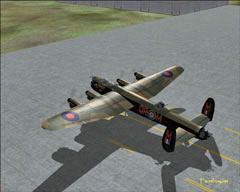
It was capable of carrying up to 22,000 pounds of bombs and soon proved to be extremely successful in its strategic bombing role. In fact, the demand was so high for these bombers that A.V. Roe (Avro) & Company could not keep up with the demand, so other industrial manufacturers were called upon to lend a hand with production. From that point on, for the next five years, a total of 7,377 Lancasterís were built.
In 1943, Avro introduced the Lancaster Mk II, which was powered by four Bristol Hercules engines, and was a bit slower than the original version, but now had the range capability of 2,250 miles. The Mk IB Special also was developed, having modified bomb bays enabling the Mk IB to carry 10 ton bombs, such as the "Grand Slam", which was that era's equivalent of a "Bunker Buster".
In 1943, Avro introduced the Lancaster Mk II, which was powered by four Bristol Hercules engines, and was a bit slower than the original version, but now had the range capability of 2,250 miles. The Mk IB Special also was developed, having modified bomb bays enabling the Mk IB to carry 10 ton bombs, such as the "Grand Slam", which was that era's equivalent of a "Bunker Buster".
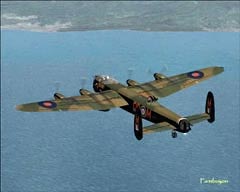
During WW II, Lancasterís carried out a total of 156,000 missions, among them the famous "Dam Buster's Raid" and the sinking of the Tirpitz, which was sunk by a 12,000 pounder. 608,612 tons of bombs fell from the bellies of the Lancaster's over the years. With four years of combat service served, 3,249 Lancasterís were lost in action, while 487 were destroyed or damaged while on the ground. There were only 24 Lancasterís to make the 100 mission mark. As you can see, the Avro Lancaster has built itself quite the reputation, along with the brave crews that flew them! They were in service in Canada up until the mid sixties. Only two are left today, in flyable condition.
The most striking feature of this model from Aeroplane Heaven, for me, was the Virtual Cockpit mode. The "virtual cabin" has seen an incredible amount of development over the past few years (time is measured in moments in the development industry!) and this model seems to represent a culmination of the art of interior aircraft development!
The most striking feature of this model from Aeroplane Heaven, for me, was the Virtual Cockpit mode. The "virtual cabin" has seen an incredible amount of development over the past few years (time is measured in moments in the development industry!) and this model seems to represent a culmination of the art of interior aircraft development!
The Lancaster is a beautiful looking aircraft, but then, I think the A-10 Warthog is too! Actually though, I really do like the looks of this aircraft, with its unique shape and configuration. The original model had a few discrepancies such as textures, prop and panel issues, but a service pack update, weighing in just a bit under 115 Mb (yeah, I know, it's a bit large, but necessary...), fixes these issues. Some issues were obvious, such as head gear on the pilots, others were not, but rest assured, this model looks and performs great! Here are the fixes that are in place with the Service Pack 1 update...
∑Texture fit on some rear fuselages.
∑Tapered props added to earlier Lancs
∑Rotol props added to Radial engine MkIIs
∑Prop Rotation on radials reversed to correct clockwise
∑BBMF now carries correct serial number
∑All Throttles, cut-offs, switches, boost gauges, tachos, featherswitches etc. now correspond to their correct engines.
∑Revised CFGs to reflect corrected text entries
∑2D Panel issues fixed
∑Revised textures on many models.
∑New pilots on some models (corrected head gear etc.)
∑Auto Controls now function correctly
Here's the aircraft and the models with the configurations that you get with the Lancaster product...
Lancaster B Mk I - 3 liveries
Lancaster B Mk I - 617 Squadron "Dam Buster's" - 2 liveries
Lancaster B Mk I with Grand Slam Bomb
Lancaster B Mk II with Hercules engines - 2 liveries (Hercules engines were used for a period of time so that the Rolls Royce Merlinís could be used for the fighters. The Hercules engines did give the aircraft a bit more range, but it was also a bit slower.)
Lancaster B Mk III with H2S Radar installation - 2 liveries
Lancaster B Mk III Aeronavale - 3 liveries
Battle of Britain Memorial Flight Lancaster
Lancaster Prototype
Not too many styles of paint jobs were provided for the Lancaster's, most being painted in a camouflage pattern, except for the Aeronavale version, which was a dark blue. The models presented in this product reflect this, but also reflect various unit designations, and some really nice nose art! Each camo job and other paints are exceptional in their detail, and very authentic looking. Great job painters!
∑Texture fit on some rear fuselages.
∑Tapered props added to earlier Lancs
∑Rotol props added to Radial engine MkIIs
∑Prop Rotation on radials reversed to correct clockwise
∑BBMF now carries correct serial number
∑All Throttles, cut-offs, switches, boost gauges, tachos, featherswitches etc. now correspond to their correct engines.
∑Revised CFGs to reflect corrected text entries
∑2D Panel issues fixed
∑Revised textures on many models.
∑New pilots on some models (corrected head gear etc.)
∑Auto Controls now function correctly
Here's the aircraft and the models with the configurations that you get with the Lancaster product...
Lancaster B Mk I - 3 liveries
Lancaster B Mk I - 617 Squadron "Dam Buster's" - 2 liveries
Lancaster B Mk I with Grand Slam Bomb
Lancaster B Mk II with Hercules engines - 2 liveries (Hercules engines were used for a period of time so that the Rolls Royce Merlinís could be used for the fighters. The Hercules engines did give the aircraft a bit more range, but it was also a bit slower.)
Lancaster B Mk III with H2S Radar installation - 2 liveries
Lancaster B Mk III Aeronavale - 3 liveries
Battle of Britain Memorial Flight Lancaster
Lancaster Prototype
Not too many styles of paint jobs were provided for the Lancaster's, most being painted in a camouflage pattern, except for the Aeronavale version, which was a dark blue. The models presented in this product reflect this, but also reflect various unit designations, and some really nice nose art! Each camo job and other paints are exceptional in their detail, and very authentic looking. Great job painters!
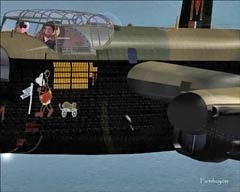
Prop textures look great as well, and do a good job showing the changes in rpm's. In the image to the left, you can see one of the "pre-SP1" screen shots. Note the modern day flight helmets. That was one of the "fixes". The control surfaces worked great, and have very smooth movement, as well with the landing gear. Reflective surfaces seemed to have just the right amount of shine, providing for an even more realistic view from the outside. An external view into the aircraft itself reveals loads of detail, which includes the animated pilots and gunners. I want to say here that there are some screen shots here that show some of those "bugs" from the initial release, i.e., the helmet issue (it was real obvious! Sorry!), but I left them in anyway for they
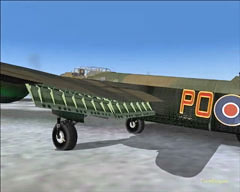












reflect both sides of the coin, and as you can see, the "heads" side of the coin wasn't too bad from the start! Here are a few more shots of the Lancaster from the exterior view...

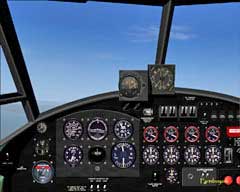
Our next stop is the flight deck and interior of the aircraft. When I first "strolled around the interior of each of the variations, all I could say was wow! Aeroplane Heaven went hog wild when it came to the modeling of the aircraftís interior compartments! We'll start with the panels, which are authentically reproduced, and very easily read, in both 2D view and VC view. Gauge refresh rates are pretty decent. This is one of those models that provide you with a 2D panel, but to get to heart of flying this classic bomber, VC mode is the way to go. Don't fret if you happen to do all of your current flying using just the 2D mode, for while in VC, the panels look identical and operate alike as well. Various pop-up panels are included, such as engineers
panel, compass, sextant, etc., some of which can be accessed either by hot keys or by slewing around in the cockpit while in VC mode. What happens when you switch views to VC mode is that it will plop you down, perhaps back in the radio compartment, depending on the model variation that you have chosen. Most of the variations of the aircraft have an A, B, C, and D option, with each one giving access to different compartments of the Lancaster. This is a pretty handy way to offer these models, as I believe this helps with the frame rates, and were pretty smooth on my system. Basically, you're not choosing a model that's loaded to the gills from nose to tail with detailed compartments, you're choosing a variation of the aircraft that you want to fly, such as variation C which includes the Pilot, Bombardier, and Front Turret stations. Workable avionics, and movable turrets are all part of this package. The different stations are very detailed, and quite colorful, I might add! While in the VC mode, you can literally work these other stations of the aircraft, for they too are outfitted for functionality, not just eye candy, although there is a bit of that tossed in for good measure! For the most part though, "walking" through this aircraft model is like taking a tour of the real thing! The folks at Aeroplane Heaven have done a great job of providing a great looking aircraft model that not only has a complex interior, but also a functioning, frame rate friendly interior as well! Night lighting was nicely subdued as well, and provided enough light to read all gauges well. It provided a very "moody effect throughout the aircraft.
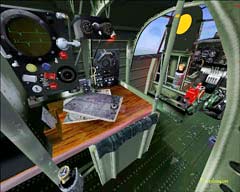
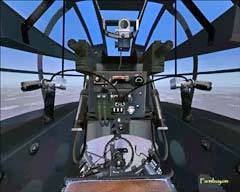
From the wood grain that can be seen on the desk of the navigator, to the complex turret array in the nose of the aircraft, one can see that to say that a lot of effort went into the making of this model is an understatement! This model is just absolutely loaded with tricks! The Flight Engineers chair will fold out for you when clicked. Grab the handlebars of the front turret and they will swing for you, no shooting at AI aircraft though, but still very impressive graphic work, to be sure! Pop your head up through the top turret, using the movement keys, or the F1 View utility that Flight1 provides for FREE, and take advantage of some views that you wouldn't normally enjoy!
Something else that's really cool about this model is the ability to carry, and drop regular bomb loads with the tell-tale wobble as they tumble out of the belly of the Lancaster, along with the two bombs that really made the Lancaster stand out from the rest...The Grand Slam, which was a 22,000 pound monster meant for deep penetration and the "really big jobs", and the very unique "Upkeep" bomb, which was a bomb that was slung under the Lancaster, and was put to spinning on an axis, before reaching the target. The "Tall Boy" is carried in one of the versions, but will not drop. These weapons were developed by Dr. Barnes Wallis, and the Tall Boy along with its big brother Grand Slam, were designed to reach the speed of sound, being nice and sleek
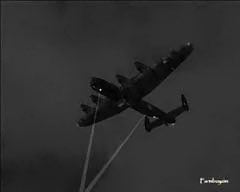
and outfitted with fins that gave the bombs a spin. As for the Upkeep bomb, it looked like a barrel that was spinning under the Lancaster. The bomb was designed to be deployed 60 feet above the water, and skipped like a stone on the waters surface until it hit the dam, where it would sink and then go BOOM!!! To aid the pilot in judging how far above the water he was, for the 60 foot altitude was imperative for the bomb to work properly, there were two beacon lights on the underside of the aircraft, one forward and one aft. These lights were angled in such a way that when the beams converged on the water into one point, that was 60 feet. Crude, but effective. The best way to drop the bombs is to open up a small view window and "fly" the aircraft from there, as you are able to make small corrections to the flight path from the bombardierís position, while using your main window for the viewing of the bomb drop. Controls in the bomb turret are functional. You need to turn and arm the bombs by clicking on the switches, then turn back, watch the site, and hit the button! Bombs away! Through the use of key commands, or while in VC mode, utilizing the lever controls, the option is up to you on how to perform some of the tasks for bombing. No other effects here though, due to the limitations of MSFS 2004. If you want to blow stuff up, fire up CFS2 or 3! There were some quirks and bugs in the initial release concerning panel and gauge issues, but all has been worked out! Great job crew! As always, I believe the best way to get the point across as to the fine work that went into this model, is by showing you, so here are a few more interior shots of the Lancaster...
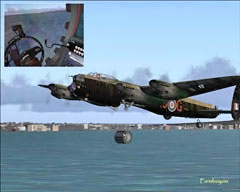


















So, I think you get the point now of how detailed this model is, and a "workable-walk-about" to boot! I think I may have just invented a new phrase! ;-) There's a real nice (for an aircraft of war) "atmosphere" within this aircraft model, which certainly adds to the realism.
The sounds were great in this product. When starting from a cold and dark configuration, (start-up and shut-down sequences are actual) you get the "pop" right before the engine turns over, along with the smoke effects. The sounds of the flaps, hatches, switches, etc., all sounded great. The flaps really gave you that "mechanical" sound. That's the only way I can describe it! Between the two different engine configurations, Merlin versus Hercules (Radial), there was, now, this is according to MY ears (Huh?) a bit of a sound difference, but others with better sound systems (and ears!) may notice more of a difference, either way, the sounds give you a good feeling of the power of these engines from listening to them do their job!
The sounds were great in this product. When starting from a cold and dark configuration, (start-up and shut-down sequences are actual) you get the "pop" right before the engine turns over, along with the smoke effects. The sounds of the flaps, hatches, switches, etc., all sounded great. The flaps really gave you that "mechanical" sound. That's the only way I can describe it! Between the two different engine configurations, Merlin versus Hercules (Radial), there was, now, this is according to MY ears (Huh?) a bit of a sound difference, but others with better sound systems (and ears!) may notice more of a difference, either way, the sounds give you a good feeling of the power of these engines from listening to them do their job!
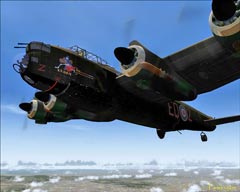
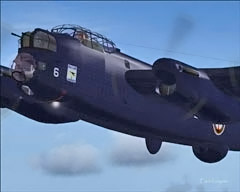
Flight dynamics for the Lancaster models feel authentic, or at least what I think a Lancaster would feel like! Compared to other high end models, this one performs well, displaying the characteristics of a heavy, four engine bomber. Turning takes a smooth hand, and coordinated rudder control. It's a pretty graceful aircraft to get off the ground and to land also. Once again, the key to this is power management and climb/descent rates. It's fairly smooth in keeping in line with the approach, not having to fight the aircraft too much to keep her steady. The Mosquito (the extra in this pack) is another story however, and we'll get to that little bonus in a moment!
Not having loads of interest in the virtual cabins of models, this one really took me by surprise! The exterior modeling and sounds are very good, providing great authenticity to this package. Textures are detailed, and give a very realistic look to the model. Overall, this is a great product, and a very nice tribute to a WW II aircraft and they're crews! The price of the product in its DVD form is £29.99 / Ä44.95 / $49.99, and is a great choice if you're into the WW II Classic Heavies!
Here are a few more shots of the Lancaster...
Here are a few more shots of the Lancaster...






Before I wrap up the review of the Lancaster, there's one more "little thing" we need to mention, and that's the bonus de Havilland Mosquito FB Mk.4 Pathfinder that also comes with the Lancaster. This "wooden wonder" was a fast, and maneuverable aircraft that usually provided recon for the Lancaster waves that would follow. It too, had an offensive capability, being able to drop light bombs, but, for the most part, the Mosquito went without other armament in favor of the speed. The Mosquito model is a nicely developed model, and is due for release on its own soon, but I do wonder about the Flight Dynamics of this particular aircraft. It's a bit tricky to fly if you like the realism settings at the max. If you're not careful, you'll end up sideways on the runway trying to take off! It was very tough to keep level and straight. I'm not sure if this is due to some bugs that are yet to be worked out or if this is how the actual aircraft flew, and if it is an accurate representation, then WHEW! Brave, that's all I can say about those crew's!!!
I can see where this would be a great aircraft for recon work. I've heard of accounts where Mosquito crews would meet up with German recon crews flying back from their own sortie, neither having
I can see where this would be a great aircraft for recon work. I've heard of accounts where Mosquito crews would meet up with German recon crews flying back from their own sortie, neither having
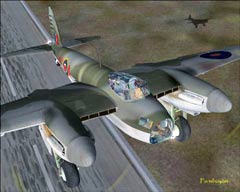
weapons, they would occasionally wave at each other. Flying this model is tougher than the Lancaster, at least I think so. Using the Loop DF for your navigation in the Mosquito is a great way to try to find your way around in the virtual skies. It's easy to use as well. For an "extra", the Mosquito is a decent model with nice exterior modeling and textures, sounds are great, and the detail in the cockpit is fantastic. It was just those flight dynamics that kept me from going straight down the runway! Could have been that thing I like to call "operator headspace", but I was working those rudder pedals like crazy! Here are a few more pics of the Mosquito...






A manual comes with the product and is a must read, both for the knowledge of the Lancaster you will find that you need to know in order to "make it work", and for the historical information that is included in the manual, which includes copies of original notes on the radio equipment used in the Lancaster, along with an account of a "typical" mission from the viewpoint of the wireless operator, who actually did more than just tune in music to listen to! The manual is a good and easy read with loads of essential information on the operation of the Lancaster. The DVD version has a manual for the Mosquito in PDF format that can be accessed from the Start Menu, Just Flight menu option.
Scenery of the RAF Scampton Air Base is also included in the product when it was in its wartime appearance. It's not too elaborate, but then, how many RAF or USAAF Air Bases were?
Scenery of the RAF Scampton Air Base is also included in the product when it was in its wartime appearance. It's not too elaborate, but then, how many RAF or USAAF Air Bases were?


FBZFS
Just Flight and Aeroplane Heaven's
Lancaster
Reviewed by Farmboyzim
Lancaster
Reviewed by Farmboyzim
www.farmboyzimsflightsims.com
I've had a great time reviewing this product, and as long as there's space on the drive, I think this one will stay in my virtual hanger for awhile!
I certainly look forward to reviewing even more products from Aeroplane Heaven! Great work!!!
For more information on this and other great products, visit www.justflight.com!
I certainly look forward to reviewing even more products from Aeroplane Heaven! Great work!!!
For more information on this and other great products, visit www.justflight.com!
Here's the details as provided from Just Flight's Website...
Detailed features
16 aircraft
Lancaster Mk1 "Standard" - 3 liveries
Lancaster Mk1 "Special" 617 Dambusters with Upkeep mine (bouncing bomb) - 2 liveries
Lancaster Mk1 "Special" with Grand Slam ('earthquake') bomb - 1 livery
Lancaster MkII with Hercules radial engines ‚Äď 2 liveries
Lancaster MkIII "Standard" with 'H2S' radar installation - 2 liveries
Lancaster MkIII Aeronavale - 3 liveries
Battle of Britain Flight BMF in modern configuration - 1 livery
Lancaster prototype - 1 livery
de Havilland Mosquito - Pathfinder/Recon
Scenery of RAF Scampton
The Lancaster is supplied with four main aircraft selectable virtual cockpits. Each Pilot station is equipped with ALL-NEW 'smooth gauge' technology for added realism!
Pilot and Navigator Stations
Pilot, front turret and bomb-aiming stations
Navigator, Radio Ops
Pilot station only
High quality sound set - relive the heady sounds of the massive engines.
Superb animations
Operating sliding windows
Operating rear crew door revealing flare chute
Operating clear-view quarter lights
All switches and controls in cockpit including weapons bay door control, bomb jettison are operable
Working armour plate headrest, swing out Radar kit, Navigators seat and folding engineer's seat
Fully functional Engineer's panel
Working turret controls to pan the turret and elevate the guns from the turret virtual cockpit
The Bomb aimer's station is fully equipped with working auto-turn control, bomb arming switches, timers, bomb computer, and bomb release
Retracting Landing lights
The airframe has correct flap operation all highly detailed, working automatic elevator counter mass tabs, rudder trim tabs and the correct gear retraction sequence
The mid upper turret rotates and the guns elevate and depress correctly to match the anti-strike track on the collar
Full crew figures (depending on the variant selected) with animated pilot, bomb-aimer and mid-upper gunner
Operating bomb bay doors with fully detailed bomb loads
Superb effects
Bombs can be armed and will drop properly and realistically with a characteristic 'wobble' on the smaller 250 and 500 pounders
The Upkeep mine will spin and drop
The Grand Slam will drop realistically
Detailed features
16 aircraft
Lancaster Mk1 "Standard" - 3 liveries
Lancaster Mk1 "Special" 617 Dambusters with Upkeep mine (bouncing bomb) - 2 liveries
Lancaster Mk1 "Special" with Grand Slam ('earthquake') bomb - 1 livery
Lancaster MkII with Hercules radial engines ‚Äď 2 liveries
Lancaster MkIII "Standard" with 'H2S' radar installation - 2 liveries
Lancaster MkIII Aeronavale - 3 liveries
Battle of Britain Flight BMF in modern configuration - 1 livery
Lancaster prototype - 1 livery
de Havilland Mosquito - Pathfinder/Recon
Scenery of RAF Scampton
The Lancaster is supplied with four main aircraft selectable virtual cockpits. Each Pilot station is equipped with ALL-NEW 'smooth gauge' technology for added realism!
Pilot and Navigator Stations
Pilot, front turret and bomb-aiming stations
Navigator, Radio Ops
Pilot station only
High quality sound set - relive the heady sounds of the massive engines.
Superb animations
Operating sliding windows
Operating rear crew door revealing flare chute
Operating clear-view quarter lights
All switches and controls in cockpit including weapons bay door control, bomb jettison are operable
Working armour plate headrest, swing out Radar kit, Navigators seat and folding engineer's seat
Fully functional Engineer's panel
Working turret controls to pan the turret and elevate the guns from the turret virtual cockpit
The Bomb aimer's station is fully equipped with working auto-turn control, bomb arming switches, timers, bomb computer, and bomb release
Retracting Landing lights
The airframe has correct flap operation all highly detailed, working automatic elevator counter mass tabs, rudder trim tabs and the correct gear retraction sequence
The mid upper turret rotates and the guns elevate and depress correctly to match the anti-strike track on the collar
Full crew figures (depending on the variant selected) with animated pilot, bomb-aimer and mid-upper gunner
Operating bomb bay doors with fully detailed bomb loads
Superb effects
Bombs can be armed and will drop properly and realistically with a characteristic 'wobble' on the smaller 250 and 500 pounders
The Upkeep mine will spin and drop
The Grand Slam will drop realistically
